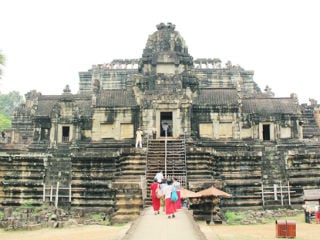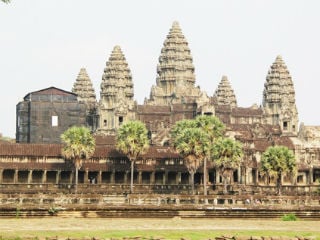Contents
- 1. Sadguru (Mrs.) Anjali Gadgil and the student seekers accompanying Her reach the capital city of Cambodia ‘Phnom Penh’ by flight from Indonesia
- 2. In spite of being a Buddhist nation, people in Cambodia having faith in Shrivishnu and Deity Shiva, and being aware of the importance of Hindu Dharma
- 3. A new scene getting enacted in the ‘Apsara’ dance every day and the participating artists wearing clothes akin to the traditional clothes worn in Bharat (India)
- 4. While explaining the reason behind depicting the scene of Samudramanthan, citizens of Cambodia mentioning about their ancestors being Hindu and having the faith that, ‘Shrivishnu protects their country’ !
Commencement of the study-tour of Cambodia, the region of Sage Koundinya !
‘The land that is referred in Mahabharat as ‘Cambhoj Desh’, is currently known as Cambodia ! Hindus used to reside here till the 15th century. It is said that ‘Hindu empire of Khmer used to rule this region from year 802 to 1421’. In fact, Cambhoj was the region of Sage Koundinya, similarly Cambhoj country was also the Naglok (Place belonging to the Naga tribes). A reference is also found mentioning that, ‘King of the Cambhoj country had participated in the war of Mahabharat’. Being a Naglok, it is also a region of Deity Shiva and it is said that the mountain Mahendra in this area has presence of Garud, vehicle of Shrivishnu. Therefore, it is also the region of Shrivishnu. In such Cambhoj country, region of HariHar (Place of Shrivishnu and Deity Shiva), Sadguru (Mrs.) Anjali Gadgil (currently, Shrichitshakti (Mrs.) Anjali Gadgil) accompanied by 4 student seekers conducted a spiritual tour on behalf of Maharshi Adhyatma Vishwavidyalay (MAV or Maharshi University of Spirituality) and this article provides highlights of this tour.
1. Sadguru (Mrs.) Anjali Gadgil and the student seekers accompanying Her reach the capital city of Cambodia ‘Phnom Penh’ by flight from Indonesia
Sadguru (Mrs.) Anjali Gadgil and 4 student seekers began their flight journey to Cambodia from the island of Bali in Indonesia on 22nd March. After taking a halt for 7 hours at the Kuala Lumpur, the capital of Malaysia, they began their journey for the final leg. After the 2 hours journey on 23rd March, they reached the capital of Cambodia, ‘Phnom Penh’ at 10:40 am. They only had the 1/2 day of 23rd March and a full day of 24th March with them. Within that limited time, they were supposed to visit the National Museum of Cambodia, the Palace of the King of Cambodia, ‘Apsara Nrutya’ – the traditional folk-dance of Cambodia and National Monument. After landing in Phnom Penh on 23rd March they came to know that, on that day the ‘Apsara Nrutya’ representing the scene of Samudramanthan (Churning of the Sea) was being shown in the premises of the National Museum. Therefore, they decided to see that dance on that day itself.
2. In spite of being a Buddhist nation, people in Cambodia having faith in Shrivishnu and Deity Shiva, and being aware of the importance of Hindu Dharma
Even though Cambodia is a Buddhist nation, people of this country have faith in Shrivishnu and Deity Shiva. People in Cambodia believe that Shrivishnu is their protector. From this we understood that the names associated with Hindu Dharma such as Garud, Vasuki, Samudramanthan, Sumeru Parvat (also known as Mount Meru), Ramayan, Mahabharat, etc., are known to the people of Cambodia and they know their importance as well. One of the proof of this is the ‘Apsara Nrutya’ being played every day in the premises of the National Museum of Cambodia ! The folk-dance art form of Cambodia is known as ‘Apsara Nrutya’. Idols of Apsaras (Beautiful and/or supernatural women from superior subtle regions) in various mudras (Body or hand posture) and depicting their dance form are carved on the walls of the Hindu Temples of Cambodia. It appears that the folk-dance art form may have originated from these idols.
3. A new scene getting enacted in the ‘Apsara’ dance every day and the participating artists wearing clothes akin to the traditional clothes worn in Bharat (India)

Everyday a different scene is enacted in the ‘Apsara’ dance. Sometimes the scene is about the abduction of Goddess Sita and the battle between vanars (Monkeys) and demons from Ramayana, sometimes the selective events from Mahabharat or sometimes the scene of Samudramanthan are enacted. The day we reached ‘Phnom Penh’, by Guru’s grace we got an opportunity to see the Samudramanthan scene in ‘Apsara’ dance (See pictures 1 and 2.). Many artists such as singers, musicians and dancers participate in the ‘Apsara’ dance wearing traditional clothes. This attire is close to the traditional attire of Bharat and is very beautiful. In spite of being a Buddhist nation and located almost 3000 Kms away from Bharat, the traditional culture of Sanatan Hindu Dharma is kept alive through this folk-dance and it is part of the Cambodian lifestyle. We felt utmost gratitude at the Holy feet of God with this experience.
4. While explaining the reason behind depicting the scene of Samudramanthan, citizens of Cambodia mentioning about their ancestors being Hindu and having the faith that, ‘Shrivishnu protects their country’ !

Before the commencement of ‘Apsara’ dance, we met an expert and a teacher of that folk-dance art form. After looking at Sadguru (Mrs.) Anjali Gadgil they said, ‘It seems that you have come from Bharat. I guessed this from the sari you are wearing. Today in ‘Apsara’ dance we are presenting the scene of Samudramanthan’. Then Sadguru Kaku asked them, “What is the reason behind showing the scene of Samudramanthan in Cambodia ?” Then the dance-expert replied, “Even though I am a Buddhist, our ancestors were Hindus. In Cambodia whoever believes in Buddha, also believes in Shrivishnu. Our faith is that Shrivishnu protects our country.” After this conversation we saw the dance depicting the scene of Samudramanthan and other traditional scenes.’

 During war, Cambodian kings provided sacred threads to soldiers for their protection
During war, Cambodian kings provided sacred threads to soldiers for their protection Bayon temple built in Angkor Thom region of Cambodia representing Buddhism and Hinduism
Bayon temple built in Angkor Thom region of Cambodia representing Buddhism and Hinduism Ta Prohm temple, Cambodia built by King Jayavarman VII for his mother at the end...
Ta Prohm temple, Cambodia built by King Jayavarman VII for his mother at the end... Banteay Srei : The Deity Shiva temple in Phnom Dei village, Cambodia
Banteay Srei : The Deity Shiva temple in Phnom Dei village, Cambodia Bapun temple built by King Udayadityavarman II of Yashodharpura
Bapun temple built by King Udayadityavarman II of Yashodharpura Angkor Wat : World’s largest Hindu temple built by King Suryavarman II in Cambodia
Angkor Wat : World’s largest Hindu temple built by King Suryavarman II in Cambodia